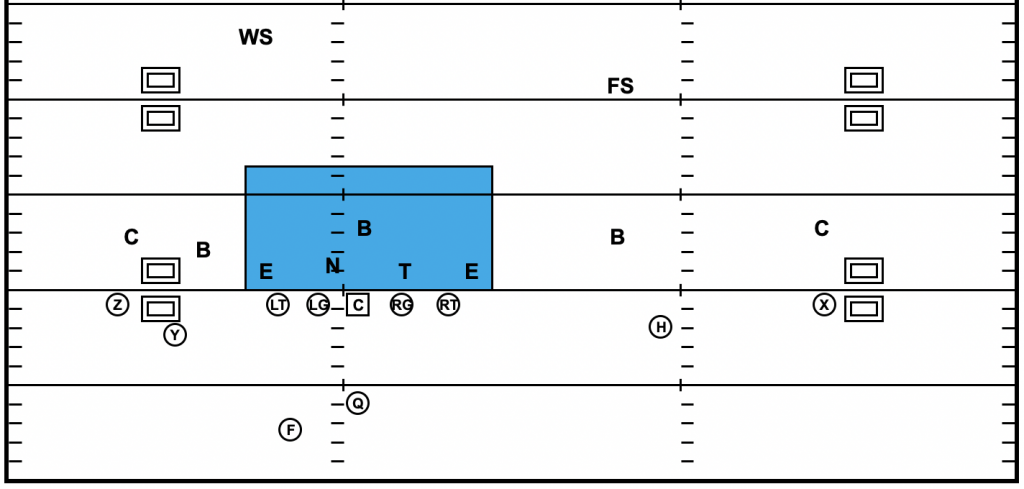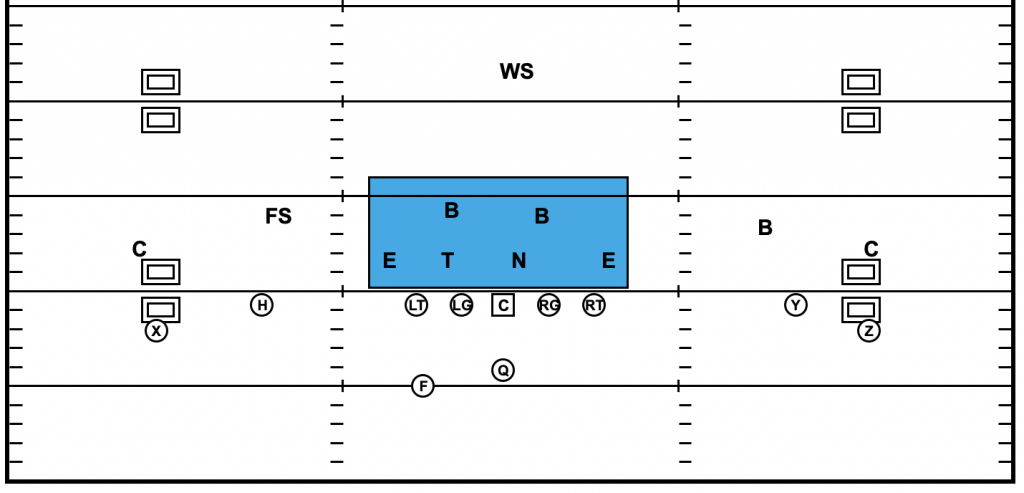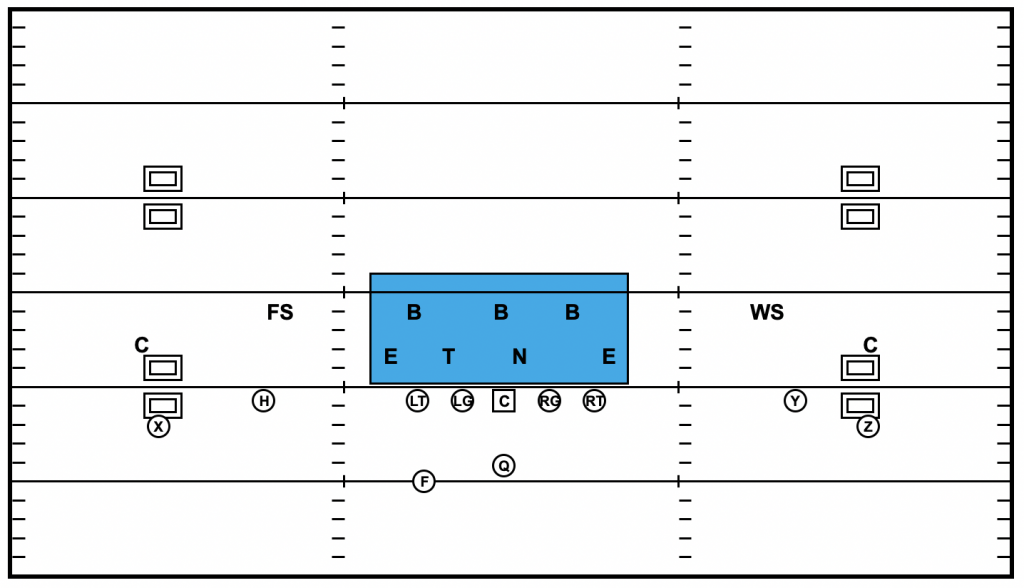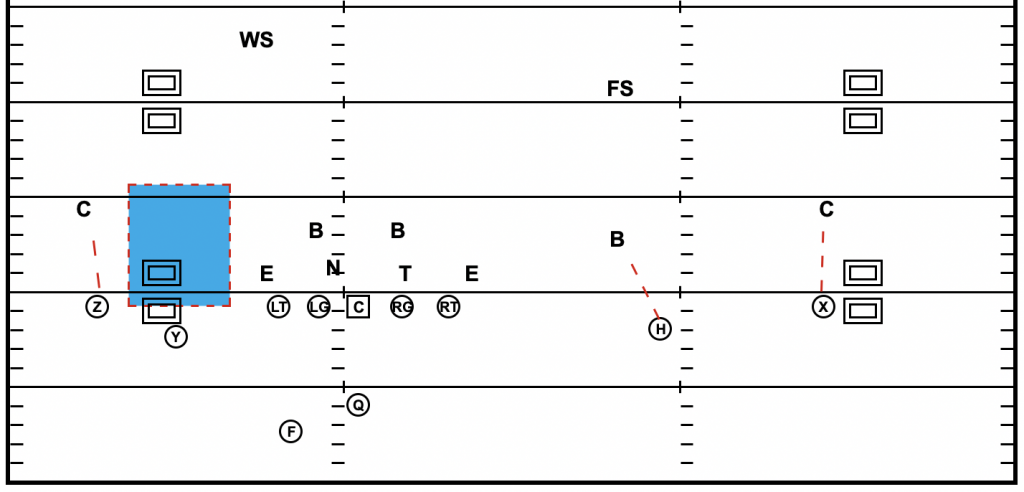Over the next few days I’m going to be talking about three ways that you can attack weaknesses in a defense or the three things you should be looking to attack when you’re looking at the game film of your opponent or when you’re scouting them in person. A lot of what you do as a coach has to do with the way a defense is lined up and where they are at, but the other part of it has to do with the personnel and who they have in the game and how good they are. Let’s dive into this now and first talk about how to attack weaknesses when you are setting up your game plan for the next game.
Counting Numbers in Your Game Plan
Here’s what I think we should talk about first, and that is the numbers. This all goes back to my understanding of basic spread offense principles. If you’re new to the spread offense, then maybe you haven’t heard of this yet. But this revolutionized the way I thought about running a spread offense (or any kind of offense) when I was first introduced to it.
Basically the idea is this, if you’re in a spread formation, we’ll say two by two, then you can easily identify how many numbers the defense has in the box. Simple right? Because what the box means is how many defenders are within a good distance to stop your run game. So basically the box is defined as somewhere close to tackle to tackle within about five yards on either side.
Sometimes players get a little bit wider and you could still call them in the box. So you might have a linebacker who’s splitting the difference between a slot receiver and your line and you technically wouldn’t consider him in the box. I would say if he’s closer than halfway, then you probably do consider him. If he’s even or farther than halfway, then you don’t consider him is just a good rule of thumb. If he’s directly apex right in the middle, he’s not considered part of the box. He’s actually got to be closer to the tackle then to the slot receiver.
You now count those players by counting the down linemen and counting the linebackers – whoever’s within about five or six yards deep. And that’s your box number.
The spread offense concept I am referring to is this…
…if the defense only has five defenders in the box defending your run game, then you want to run the ball. It just makes sense. You have five blockers in a formation like that. You’ve got five linemen and a running back, so that gives you a six on five advantage. So now you can get a hat on a hat and that’s a great situation to run the ball because there are no blockers left unblocked.

If they think that they’re going to sneak a guy into the box late, you can either account for an extra guy or even read the guy and see if he’s going to jump in late to shut it down. So in this case, your quarterback would read an outside linebacker as he’s meshing with the running back. And if that outside linebacker bites in on the handoff then the quarterback can pull it, but he would have to really bite in because you’re assuming he’s not in the box initially, he’s pretty far out there.
So really when you get five in the box with 5 blockers, you should be running the ball mostly – it’s an automatic in my book.
The next possible number you could get is six men in the box. So now let’s say you’ve got four down linemen and two linebackers. Now this is a situation where you can do one of two things. You can run the ball or you can throw the ball. And the reason I say that is because if you run the ball, now you have that extra defender you cannot block – so you have to account for him. So either you have to motion somebody into the box and block that extra defender or maybe you run the ball with your quarterback and your running back becomes the extra blocker. But you never want to try to run the ball when you don’t have enough blockers. It just doesn’t work out that well very often. One other “option” is to option that extra defender in some way. And so six in the box is still a really good formation to run the ball against. I like running the ball against six in the box. There’s nothing wrong with it at all. Especially in High School where running the football can win you a lot of games. It equals time of possession and confidence.

What else should you run with 6 in the box? It’s also a good situation to run some play action fakes because now they’ve got an extra defender up close and you’ve got a little better look with your receivers not being covered quite as well downfield.
The next situation you may see against the 2×2 formation is seven in the box. When you’ve got seven defenders in the box, that only leaves four defenders to stop the 4 receivers. So there’s only four defenders guarding your four receivers. Now here’s the situation that gets us spread coaches in some trouble because teams will clamp down. They’ll run man to man, either a soft man or a tight man and we start thinking, “Oh man, this is perfect. Let’s score on this next one.” Well you don’t need to score on every play. You just need to hurt them enough to get them out of that look.
It’s not a great defensive look because it is risky, but unfortunately the percentages are still stacked against your favor unless you have practiced it and don’t panic. This is the kind of thing I think a lot of youth coaches see when they try to run a spread offense. The defensive coordinator will just bring them all and the line and QB just can’t handle the pressure.

This is why you need a Blitz Pressure period offensively to work on these things. Make sure you game plan your offensive calls versus the most likely defensive pressure you think you will see. The Offensive line coach should be drawing them all up and showing them to your lineman and the line themselves should practice a blitz and stunt period before the whole team gets together for the Blitz Pressure period.
One thing you definitely don’t want to do is work against completion percentages. These are still stacked against your favor if you’re going to try and go deep all the time whenever you see this look. Yeah, you might complete one for a long score or a long play. But most times defenses are coming after you. They’ve got seven guys and you’ve only got five linemen and a back to protect. So at least one guy is coming free. Now your quarterback doesn’t have a whole lot of time to throw it and they’re just coming after you. It’s kind of that attack mentality. So in this kind of a situation, yes, throwing the ball is a good idea, but I want you to think about what you can do to make it a high percentage pass.
Ideal high percentage passes against these looks would be things like simple little rub routes or pick routes because the defense has to be in man. Those are the kinds of plays that you should really be running in that situation.
I also like to try to move the pocket and get the Quarterback on the run. This can do wonders for your QB’s vision because now he doesn’t have to try to find windows to throw through or linemen to throw over.
There may also be some run plays you can either stay in or adjust to. For example, if you can get an edge on them, you can run speed option. You might even be able to get a jet sweep if you can capture the edge with an extra Tight End, but it’s probably more unlikely that you can get that without motioning somebody in or if a defense is going to play you that way, just get out of that formation.
Sometimes I wonder why coaches get stuck in a formation where they don’t have easy answers. And if it’s too stressful for your quarterback or for your offense, why are you in that formation to begin with? You don’t have to be sold out to that. I like running spread formations, but if defenses have the capability to defend us that way or we aren’t good enough to make them pay, then staying in a 2 x 2 is not going to be worth it.
Scouting Numbers in the Secondary
When I’m talking about numbers in the secondary, I’m referring to how many defenders are over how many receivers. I’m also talking about the level they are defending.
Let’s take your typical spread 2 x 2 again. Some teams will actually NOT cover your inside receiver to one or both sides! By cover I mean have a defender within 5 yards laterally and 7 yards deep. If your receiver has no one close to them, guess what….
…THROW IT TO THEM!
I’ve seen this more often when the ball is one the hash and the boundary slot is uncovered. This is a great opportunity to run a stack look to the boundary.

Speaking of stack looks, if only one defender is defending the stack, then yes, one of your receivers is uncovered. Same rule applies…throw the ball NOW to the uncovered receiver.
When you put three receivers out in a trips formation, many defensive coordinators will not cover one of the two inside receivers.
Again, you have a numbers advantage that should be attacked with a quick now route (smoke) or a Bubble Screen.
Numbers With All Formations
When you are not running a spread offense, the numbers counted vs the run are factored in differently. Once you add in a Tight End to your formations plus 2 or 3 backs, you now will see 7 or possibly 8 defenders in the box.
I’m not going to even try to go into all the possibilities of every different kind of offensive system in this series, but I will say this:
When you are setting up a game plan, you have to consider how each of your plays can be run against anything that a defense can throw against you. You have to have a plan. You can’t just go into it assuming you know exactly what they are going to do.
The entire first part of this series is to show you the importance of creating situations in practice that are most likely to be what you will see in a game against your next opponent.
This is done with detailed practice scripting.
A great practice script and using them regularly allow you to make sure you address all the possible situations and be confident in handling them as a team.
Practice scripts should include not just the play you want to run, but also the situation of the game you are replicating like down, distance, field position, hash and defensive alignment.
A well scripted period that doesn’t waste time is run through at game tempo. But you have to have a script to do this. You also need to have defensive cards drawn up so they can show you the look you want against each play.
Yes, scripting takes time. But in my opinion, it will have the greatest effect on your offense when done correctly.
This concludes the Part 1 of the Game Planning Strategy Topic that we are currently covering.
Very soon we will cover Part 2 – Stay tuned or join our mailing list so you will be sure to not miss out.
- Coach Hahnstadt



Thanks for the information….good notes